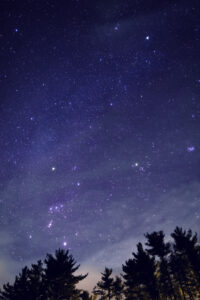What to look for in the winter sky
December 19, 2023
Posted by Lake Erie Nature and Science Center

The winter solstice will occur on Thursday, December 21 when the Sun reaches its southernmost position in the sky. The least amount of sunlight will reach Earth, marking the first astronomical day of winter and the shortest day of the year. Here are some of the constellations and planets to observe during the long winter nights this season.
Orion
One of the biggest and brightest constellations in the night sky is Orion the Hunter. First, look southeast for 3 equally bright stars in a straight line which form “Orion’s belt”. Serving as his right shoulder is the supergiant star Betelgeuse which shines brightly with a reddish tint. At Orion’s left foot lies the slightly brighter star, Rigel. Hanging below the center star in Orion’s belt is his sword which features the Orion Nebula, or Messier 42. Visible as a dim fuzzy object to the naked eye, this nebula appears as a large gas cloud when viewed with binoculars or a small telescope.
Evening Planets
High in the southeastern sky after sunset, you will see one very bright object which is our Solar System’s largest planet, Jupiter. Jupiter shines brighter than any nearby star due to its size (1,300 times the size of Earth!) and its highly reflective clouds. Towards the southwestern sky you will see an object dimmer than Jupiter but still brighter than the nearby stars, this is Saturn. Details of both of these planets can be seen with small telescopes and large binoculars. Take advantage of this opportunity while you can, as these beautiful planets will be lost in the light of sunset by February.
Morning Planets
Looking east before sunrise you will see an incredibly bright object, the planet Venus. Venus is sometimes referred to as “The Morning Star” or “The Evening Star” depending on its orbit. Venus is not a star, but in fact our closest planetary neighbor in space. Venus is the third brightest object in the sky after the Sun and Moon due to its proximity to Earth and its highly reflective clouds. Through a telescope or binoculars, you can observe the phases of Venus including January’s gibbous phase. Mercury is also becoming brighter in the morning sky which can be observed in early January to the lower left of Venus.
Learn more about the winter sky by visiting Lake Erie Nature & Science Center for a planetarium program. View schedule and purchase tickets at www.lensc.org/planetarium.

